- Home
- Harlan Ellison
Approaching Oblivion
Approaching Oblivion Read online
APPROACHING OBLIVION:
Road Signs on the Treadmill Toward Tomorrow by Harlan Ellison®
Copyright © 1974 by Harlan Ellison. Copyright © 1985 by The Kilimanjaro Corporation. Renewed, 2002 by The Kilimanjaro Corporation
ISBN-10: 0-7592-9156-X
ISBN-13: 978-0-7592-9156-0
APPROACHING OBLIVION
is an Edgeworks Abbey® Offering in association with ereads.com. Published by arrangement with the Author and The Kilimanjaro Corporation.
Harlan Ellison and Edgeworks Abbey are registered trademarks of The Kilimanjaro Corporation.
This edition is copyright © 2008 by The Kilimanjaro Corporation. All rights reserved.
Front Cover Photo by Stathis Orphanos. Copyright © Stathis Orphanos.
First E-Reads publication: 2009
www.ereads.com
Harlan Ellison website: www.harlanellison.com
No part of this book may be reproduced or transmitted in any form or by any means electronic or mechanical—including photocopy, recording, Internet posting, electronic bulletin board or any other information storage and retrieval system, or by any other method, means or process of embodying and/or transmitting information, text or the spoken word now known or hereafter devised without permission in writing from The Kilimanjaro Corporation, except by a reviewer who may quote brief passages in a critical article or review to be printed in a magazine or newspaper, or electronically transmitted on radio, television or in a recognized on-line journal. For information address Author’s agent: Richard Curtis Associates, Inc., 171 East 74th Street, New York, New York 10021, USA.
All persons, places and organizations in this book-except those clearly in the public domain-are fictitious and any resemblance that may seem to exist to actual persons, places or organizations living, dead or defunct is purely coincidental. These are works of fiction.
Foreword: “Approaching Ellison” by Michael Crichton, copyright © 1974 by Michael Crichton.
“1984 Introduction to the Introduction,” copyright © 1985 by The Kilimanjaro Corporation.
“Introduction: “Reaping the Whirlwind,” copyright © 1974 by Harlan Ellison. Renewed, 2002 by The Kilimanjaro Corporation.
“Knox,” copyright © 1974 by Harlan Ellison. Renewed, 2002 by The Kilimanjaro Corporation.
“Cold Friend,” copyright © 1973 by Harlan Ellison. Renewed, 2001 by The Kilimanjaro Corporation.
“Kiss of Fire,” copyright © 1972 by Harlan Ellison. Renewed, 2000 by The Kilimanjaro Corporation.
“Paulie Charmed the Sleeping Woman,” copyright © 1962 by Harlan Ellison. Renewed, 1990 by The Kilimanjaro Corporation.
“I’m Looking for Kadak,” copyright © 1974 by Harlan Ellison. Renewed, 2002 by The Kilimanjaro Corporation.
“Silent in Gehenna,” copyright © 1971 by Harlan Ellison. Renewed, 1999 by The Kilimanjaro Corporation.
“Erotophobia,” copyright © 1971 by Harlan Ellison. Renewed, 1999 by The Kilimanjaro Corporation.
THIS IS CALLED THE SPLASH PAGE! IT IS SUPPOSED TO MAKE YOU WANT TO BUY THIS BOOK MORE URGENTLY THAN MILK FOR STARVING CHILDREN! BUT JUST BETWEEN US, IT’S ALL HYPE. YET TRADITION DEMANDS…SO…
The New York Times called him “relentlessly honest” and then used him as the subject of its famous Sunday Acrostic. People Magizine said there was no one like him, then cursed him for preventing easy sleep. But in these stories Harlan Ellison outdoes himself, rampaging like a mad thing through love (“Cold Friend”, “Kiss of Fire”, “Paulie Charmed the Sleeping Woman”), hate (“Knox”, “Silent in Gehenna”), sex (“Catman”, “Erotophobia”), lost childhood (“One Life, Furnished in Early Poverty”) and into such bizarre subjects as the problems of blue-skinned, eleven-armed Yiddish aliens, what it’s like to witness the end of the world and what happens on the day the planet Earth swallows Barbra Streisand. Oh yeah, this one’s a doozy!
To the memory of
WALTER FULTZ,
the first editor to buy a book
from me: a good man, a fine editor,
a friend…
Who approached oblivion,
passed through it, and is gone,
for what reasons I do not know….
Though I saw him seldom,
I miss him greatly….
With luck, he’s found peace
at last.
1974 Acknowledgments
I didn’t do it alone. Others helped. Some in tiny ways they won’t even remember. Others with encouragement, assistance, research and love. They will remember. Robert Silverberg, Jack Dann, Vicky Schochet, Stephanie Bernstein, Steve Herbst, Andrea Hart, Ben Bova, Damon Knight, Kate Wilhelm, Joe Haldeman, Ed Bryant, Jim Sutherland, Sam Walker, Helen D’Alessandro Hecht, Leo & Diane Dillon, Lynn Lehrhaupt, Art Frankel, Jim Wnoroski, Ed Ferman, Toby Roxburgh, Tim Seldes and Mike Seidman. And Leslie Kay Swigart, because I forgot to acknowledge her help with Again, Dangerous Visions. And, of course, as always, Bob Mills and Marty Shapiro, who are due for sainthood any moment. Gypsy da Silva copy edited this book in its manuscript stage with grace and insight and an attention to the primacy of the writer’s creation that is rare as black diamonds in the publishing industry; and I love her shamelessly for it. Special thanks are due Lynda Mitchell, but that’s none of your business.
1984 Acknowledgments
Some of the people named above I haven’t seen in ten years Nonetheless, they were there when this book was new and the world was younger. Since that time, add to the list Gil Lamont and Sharon Buck and Sarah L. Wood and Jim Frenkel and Barclay Shaw. I wonder whatever happened to Lynda Mitchell? But that’s another story.
Contents
FOREWORD by Michael Crichton
1984 Introduction to the Introduction
INTRODUCTION by Harlan G OBLIVION
1. Knox
2. Cold Friend
3. Kiss of Fire
4. Paulie Charmed the Sleeping Woman
5. I’m Looking for Kadak
ELLISON’S GRAMMATICAL GUIDE AND GLOSSARY FOR THE GOYIM
6. Silent in Gehenna
7. Erotophobia
8. One Life, Furnished in Early Poverty
9. Ecowareness
10. Catman
11. Hindsight: 480 Seconds
FOREWORD by Michael Crichton
Approaching G OBLIVION
Soon after I came to Los Angeles in 1970, I was called by a producer who offered me a job writing a science fiction screenplay. I was tied up with a book at the time; the producer asked me if I could suggest another writer for the project. I suggested Harlan Ellison.
There was a long, chilly silence at the other end of the phone. Finally the producer cleared his throat and said, “Do you, ah, know Harlan Ellison?”
No, I said, I didn’t. I knew him only through his work. I had read some of his stories, and seen some of his television scripts.
“Umm,” the producer said. “Well, let me tell you something—” and he launched into a short, energetic, and wholly unprintable description of his feelings on the subject of Harlan Ellison. The outburst ended as abruptly as it began, and he got off the phone leaving me completely mystified. I could only assume that Ellison and this producer had had some acrimonious dealings in the past. But that is hardly a rare event in Hollywood, and I thought no more about it.
As time went on, I ran into many people who had had acrimonious dealings with Harlan Ellison. There was an odd sameness about the way all these people talked. “He’s very inventive, very enthusiastic, very talented,” they would begin, “but—” and then they’d launch into a long and heated harangue, cataloging what they regarded as the innumerable abuses they had suffered at his hands. I was told that Ellison was a perfectionist; that he cared too much abo
ut his work; that he fought for his ideas; that he was demanding and quick to pull his name from any project which did not go as he intended—always substituting the sarcastic psuedonym, “Cordwainer Bird.”
None of this elicited much sympathy from me. I saw nothing wrong with caring about your work and fighting for your ideas. I had been doing the same thing, and for my trouble I had been fired by Universal and then sued by that company. So I was in the position of admiring Ellison more with every new complaint I heard about him.
The people who spoke so bitterly about Harlan Ellison all mentioned something else, too. At the end of their diatribes, they would pause to catch their breath, and then conclude with: “And besides, did you see what Gay Talese said about him?”
Gay Talese had written an Esquire piece called “Frank Sinatra Has A Cold” which reported an encounter between Ellison and the singer. Ellison comes off as disrespectful, witty, and refusing to be bullied. It is hardly the protrait of a blackguard and cur which his critics felt it to be.
In the end, I suppose what impressed me most about these Ellison stories was the strength of feeling with which they were told. The facts—so far as they could be determined—were never very remarkable, but the emotional content was always fierce and highly charged. Somehow, Ellison had really gotten to them, and they would never forget it.
Some time later, this same Harlan Ellison began to attack me in print. His argument was that I wasn’t writing good science fiction, which was fine by me—I didn’t think I was writing science fiction at all—but it was irritating to be placed in an unwanted category and then told I didn’t fit it well. I was back at Universal by then, and one day I was complaining about his attacks on me when a secretary looked up and said, “Do you, ah, know Harlan Ellison?”
No, I said, I didn’t.
“Well,” she said. “I used to be his secretary and I know him very well. Would you like to meet him?”
Harlan Ellison lives in the Los Angeles foothills, in a perfectly ordinary-appearing house, in a quiet suburban neighborhood. The inside of the house is as remarkable as the exterior is mundane; Ellison himself seems to take a certain pleasure in the unobtrusive outward appearance he presents to the community.
Inside, the feeling is sensual, almost sybaritic, with a quality of tension that comes from a barely controlled chaos. There are books everywhere, thousands of books, lining walls, tucked above doorways, filling closets, threatening to spill out and consume the living space. There are bizarre juxtapositions at every turn: signed Wunderlich prints, Soleri notebooks, sculpture from Mozambique, psychedelic book art set side by side in confusing profusion. It takes enormous energy to hold all this together, and Ellison himself appears to have boundless energy. He moves restlessly, talks non-stop, jumping from books to television to politics to sex to movies, taking up each new subject with considerable humor and aggressive enthusiasm.
He is not an easy man. His opinions are strongly held and his feelings strongly felt; he is not tolerant of compromise where it affects his life and his work. In someone else, this obstinacy might appear petty or fanatical, but in Harlan it is natural and attractive. It is simply the way he is.
Most strikingly, he is a genuine original, one-of-a-kind, difficult to categorize and unwilling to make it any easier. He demands to be taken on his own terms, and that aspect of his personality and his work is, I suspect, what has engaged both his critics and his large and passionately loyal following. He seems to be a kind of energy focus and no one who brushes against him comes away with an indifferent response. His advocates are every bit as vehement as his critics. Other writers have readers; Ellison has fans who will get into fistfights with anyone who says a word against him.
He doesn’t write like anybody else. The same paradoxes and odd juxtapositions which appear in his house and in his casual speech, are present in all of his writing. What emerges is a surprising, eclectic, almost protean series of visions, often disturbing, always strongly felt.
In the end, these strong feelings drive Hollywood producers crazy but make extraordinary stories. After a long hiatus, there are eleven here, in top Ellison form—uncompromising, individual, and exactly as he wants them to be.
Hollywood
29 January 74
1984 Introduction to the Introduction
What you are about to read was written in 1974. It came to the page at the end of a decade of civil unrest in America that awakened a national social conscience too long in a state of narcolepsy. From 1963 till these words that follow were set down, this is what I saw and lived through in my world:
Race riots in Birmingham, Alabama that prompted President John F. Kennedy to call out 3000 troops; 200,000 Black and White Freedom Marchers congregated in Washington; investigative journalists began revealing the depth of outright lies we had been fed about what was happening in Cuba and Vietnam; Kennedy was assassinated; Lee Harvey Oswald was smoked; racist Ian Smith was elected Premier of Southern Rhodesia; the summer of blood in 1964 culminating in the Harlem riots and a year later the burning of Watts; escalation of the war in Vietnam; the march from Selma to Montgomery; Malcolm X shot to death in Harlem; Lyndon Johnson’s presidency intensified the Vietnam incursions; ongoing conflict in the Middle East culminating in the Six-Day War; 50,000 people demonstrate against the Vietnam War at the Lincoln Memorial; Johnson driven out of office; Martin Luther King, Jr. assassinated; Muhammad Ali’s boxing title taken from him because he refused to fight in Vietnam; Senator Robert F. Kennedy was assassinated; the Democratic Convention riots in Chicago; Nixon elected 37th President of the United States with the narrowest margin since 1912; the war in Northern Ireland escalates; the Russians occupy Czechoslovakia and a Czech student, Jan Palach, burns himself to death in protest; the “Chicago Eight” are tried; Lt. Calley and My Lai; Nixon starts to realign the Supreme Court to fit his needs; the war in Biafra; the Kent State University massacre; the U.S. bombs Cambodia, the war spreads to Laos; Idi Amin takes over Uganda; the Pentagon Papers; India and Pakistan go to war; Watergate; Nixon reelected; George Wallace shot; Britain imposes direct rule on Northern Ireland; arab terrorists killed Olympic athletes; Marcos assumes dictatorial powers in the Philippines; Agnew resigns in disgrace; the occupation of Wounded Knee; Allende of Chile is assassinated and his government overthrown with what will come to be revealed as the direct intervention of the CIA; and not too far off was the threatened impeachment and eventual resignation of Nixon.
And that was only the part of what was happening that shows up in my daily logs, only that part of the world around me that I haven’t blissfully erased from memory. Don’t ask what was happening in my personal life.
What you are about to read was the state of mind of a writer weary from a decade of violence, protest, pain and death. There were rivers of blood and mountains of dead. It was a bleak time, yet there had been concern; there had been the miracle of an entire nation coming to its feet with its fists raised against the inhumanity of the times.
Since APPROACHING OBLIVION was first published, I have received hundreds of letters from people telling me that I shouldn’t be so cynical, that I should look on the bright side. Most of them never bothered to notice that the words in the introduction were a decade old. They just wanted me to look on the bright side. And I would, really I would; if Jerry Falwell and Alexander Haig and Phyllis Schlafly and James Watt and Meyer Kahane and Qadaffi and Prime Minister Botha and little creeps like Lou Stathis were not out there standing in the dark side, waiting to make life unnecessarily crummy for you and me and lots of little kids who’ll grow up to read this same introduction ten years hence.
All those letters chided me for being so downbeat. They started out by upbraiding me, but before they concluded they wound up offering apologia for themselves. “I haven’t given up,” they say. “I’m a good person! I don’t litter, and I don’t support the National Rifle Association, and I don’t blah blah blah.” And I look at those letters and think: Why do they feel guilty if they’re s
o above reproach…do they, also, feel as if they’re approaching oblivion?
And it’s ten years since I wrote that introduction, and the spirit of Thoreau-like civil disobedience has dissipated like troublesome morning fog, and Jerry Rubin, when last seen, was selling insurance in Marin County, or something like that.
It’s ten years, and to my amazement I’m still here. Most of my writer friends use word processors while I still bang away on this Olympia manual; they tore down the Brown Derby to make a parking lot; Walter Tevis and Phil Seuling and Bert Chandler and a bunch of my other friends have died; New York City ain’t fun no more; and with the exception of Skor, you’ll have a hard time finding a decent candy bar in the States; but I’m still here, still shaking my head in dismay at what Penthouse and the hypocrites who run the Miss America contest did to Vanessa Williams; still here anxious to look on the bright side, but somehow finally convinced that a few of us are doomed forever to view with alarm so the rest of you don’t get too cozy.
Don’t for an instant believe that I’m unaware of the unseemly hubris freighting such remarks, and I’d have it otherwise if I could…but there’s this quote from Benedetto Croce (1866–1952), the Italian philosopher, statesman, literary critic and historian, that suggests, “Liberty is better served by presenting a clear target to one’s opponents than by joining with them in an insincere and useless brotherliness,” and I find myself again and again denied the simple pleasures of the bright side. So do me a favor, and don’t write me no letters telling me I’m a sourpuss. In a world where John Landis continues to make movies, how can one be anything but alarmed. And don’t send your toddlers to the McMartin pre-school.

 Repent, Harlequin! Said the Ticktockman
Repent, Harlequin! Said the Ticktockman Broken Glass
Broken Glass Other Glass Teat
Other Glass Teat Memos From Purgatory
Memos From Purgatory I Have No Mouth and I Must Scream
I Have No Mouth and I Must Scream The Deadly Streets
The Deadly Streets The Glass Teat
The Glass Teat Paingod and Other Delusions
Paingod and Other Delusions No Doors No Windows
No Doors No Windows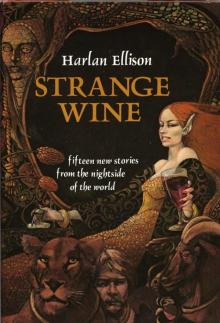 Strange Wine
Strange Wine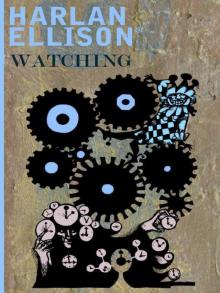 Harlan Ellison's Watching
Harlan Ellison's Watching Over the Edge/An Edge in My Voice
Over the Edge/An Edge in My Voice Troublemakers: Stories by Harlan Ellison
Troublemakers: Stories by Harlan Ellison Gentleman Junkie and Other Stories of the Hung-Up Generation
Gentleman Junkie and Other Stories of the Hung-Up Generation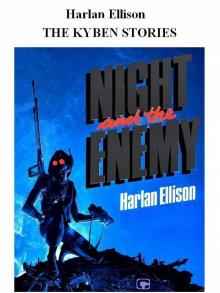 The Kyben Stories
The Kyben Stories From the Land of Fear
From the Land of Fear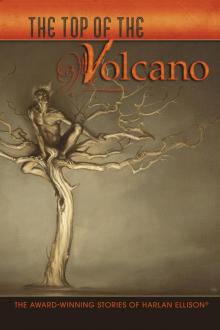 The Top of the Volcano: The Award-Winning Stories of Harlan Ellison
The Top of the Volcano: The Award-Winning Stories of Harlan Ellison Sleepless Nights in the Procrustean Bed
Sleepless Nights in the Procrustean Bed Ellison Wonderland
Ellison Wonderland Children of the Streets
Children of the Streets Can & Can'tankerous
Can & Can'tankerous Love Ain't Nothing but Sex Misspelled
Love Ain't Nothing but Sex Misspelled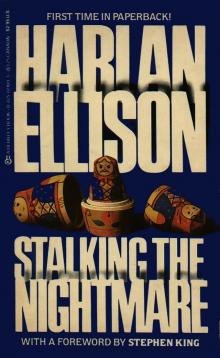 Stalking the Nightmare
Stalking the Nightmare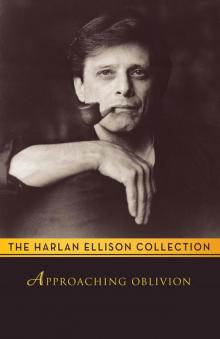 Approaching Oblivion
Approaching Oblivion Deathbird Stories
Deathbird Stories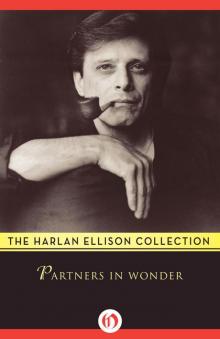 Partners in Wonder
Partners in Wonder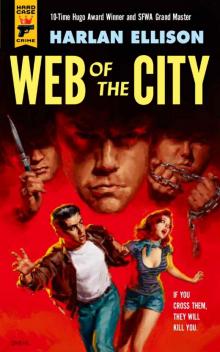 Web of the City
Web of the City Spider Kiss
Spider Kiss A Boy and His Dog
A Boy and His Dog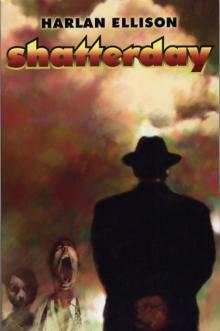 Shatterday
Shatterday Slippage: Previously Uncollected, Precariously Poised Stories
Slippage: Previously Uncollected, Precariously Poised Stories Repent, Harlequin! Said the Ticktockman
Repent, Harlequin! Said the Ticktockman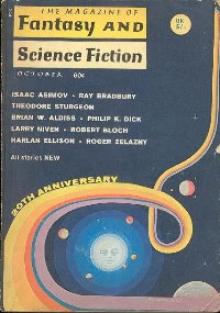 Come to Me Not in Winter's White
Come to Me Not in Winter's White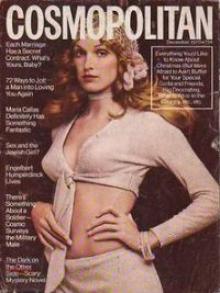 The Song the Zombie Sang
The Song the Zombie Sang The Other Glass Teat
The Other Glass Teat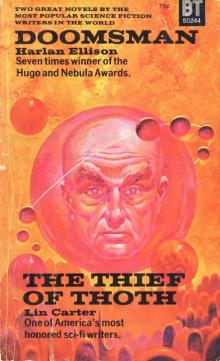 Doomsman - the Theif of Thoth
Doomsman - the Theif of Thoth The City on the Edge of Forever
The City on the Edge of Forever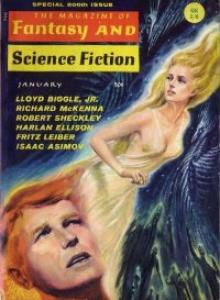 I See a Man Sitting on a Chair, and the Chair Is Biting His Leg
I See a Man Sitting on a Chair, and the Chair Is Biting His Leg The Harlan Ellison Hornbook
The Harlan Ellison Hornbook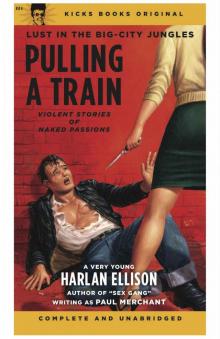 Pulling A Train
Pulling A Train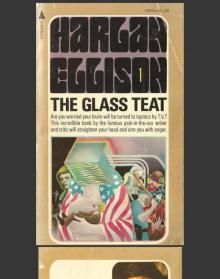 The Glass Teat - essays of opinion on the subject of television
The Glass Teat - essays of opinion on the subject of television An Edge in My Voice
An Edge in My Voice Angry Candy
Angry Candy Troublemakers
Troublemakers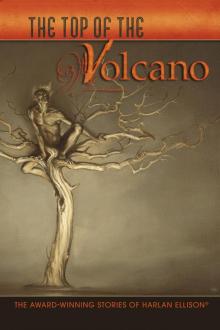 The Top of the Volcano
The Top of the Volcano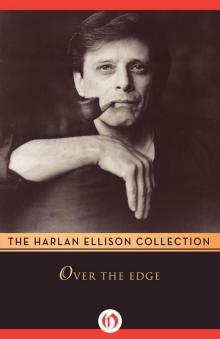 Over the Edge
Over the Edge Survivor #1
Survivor #1 Slippage
Slippage